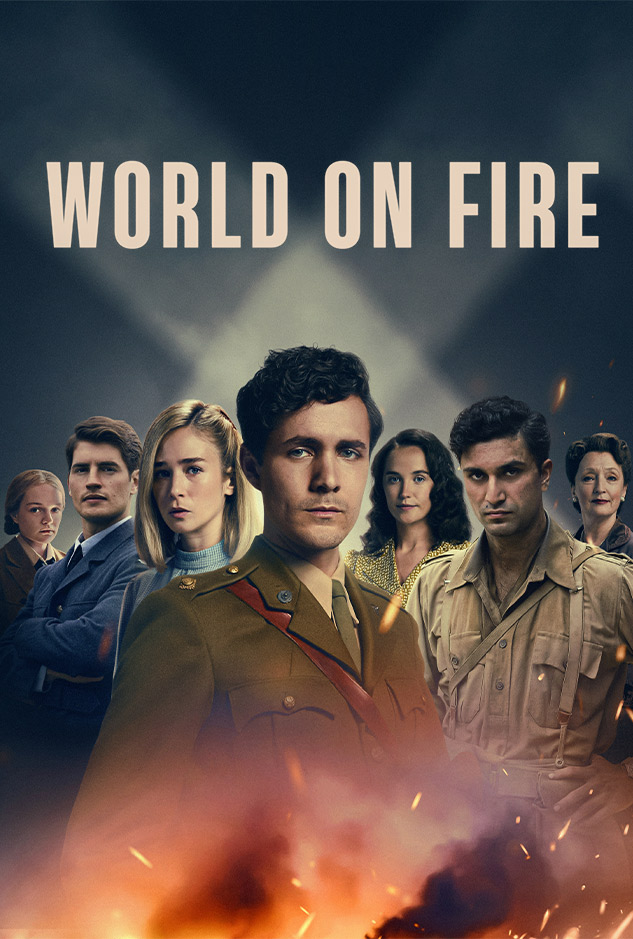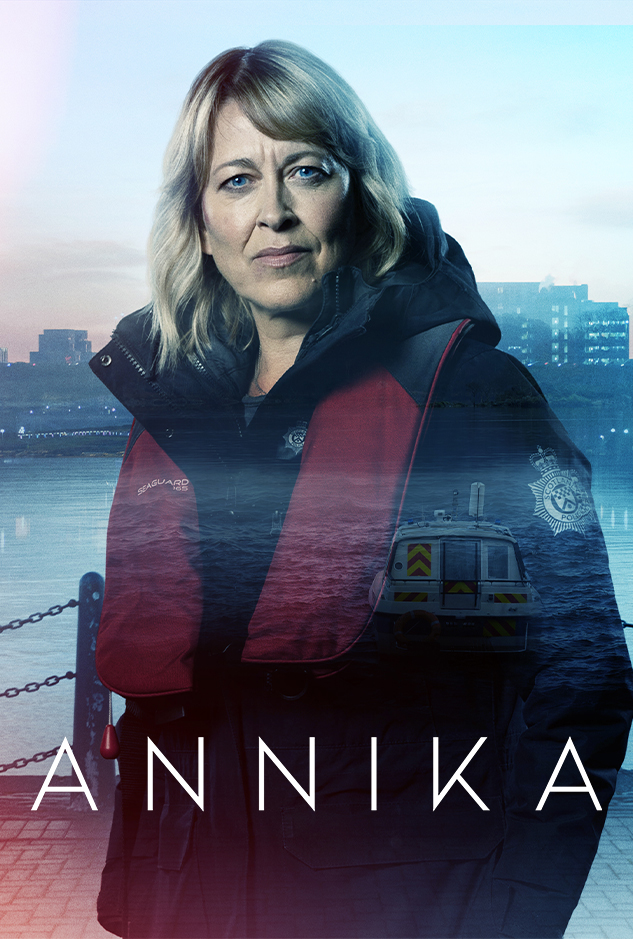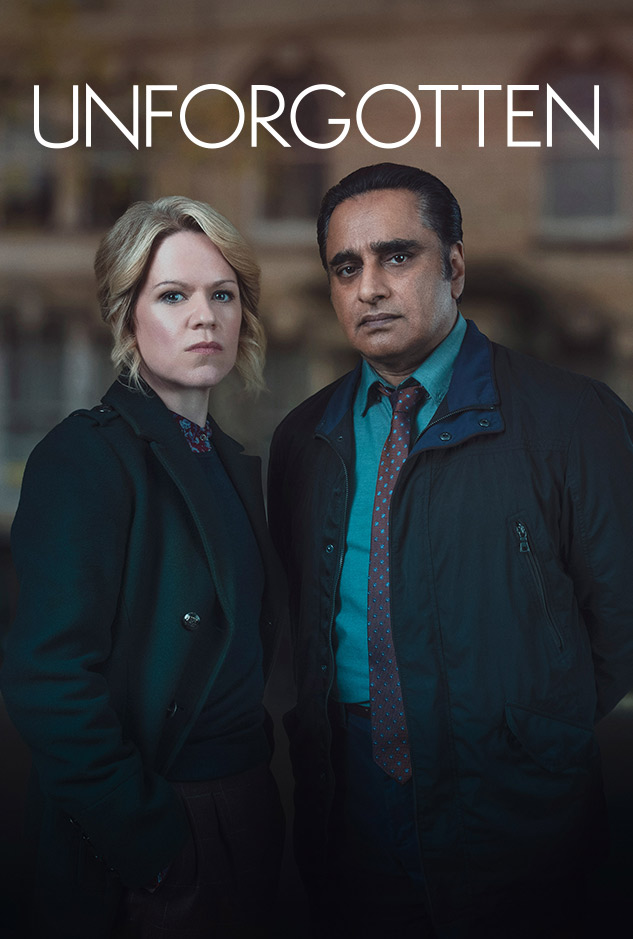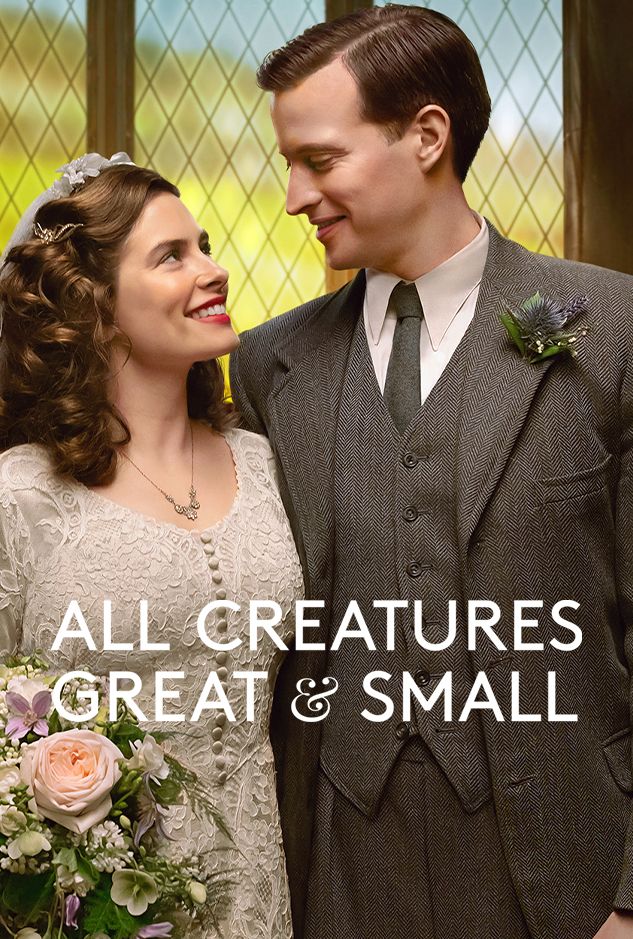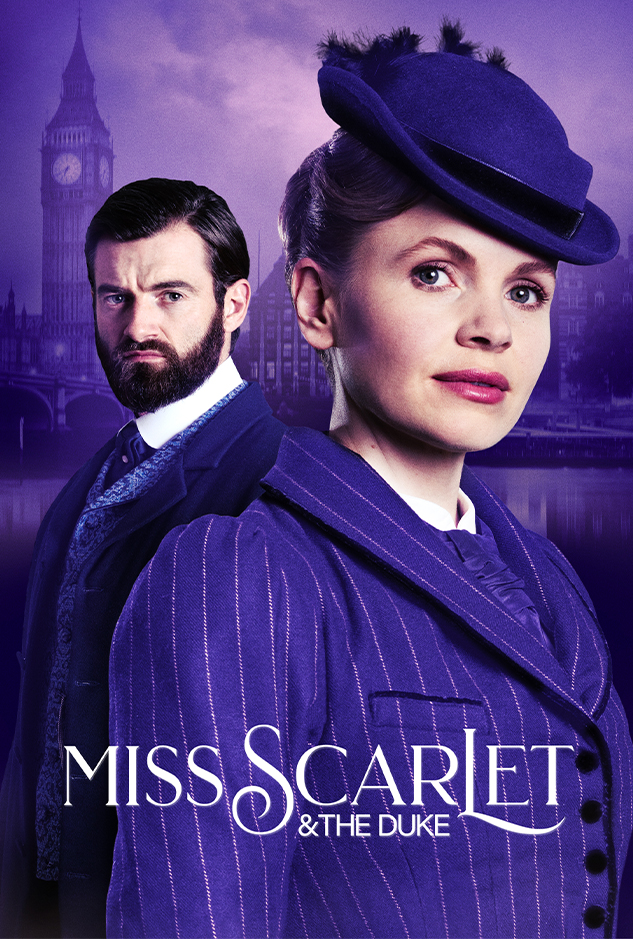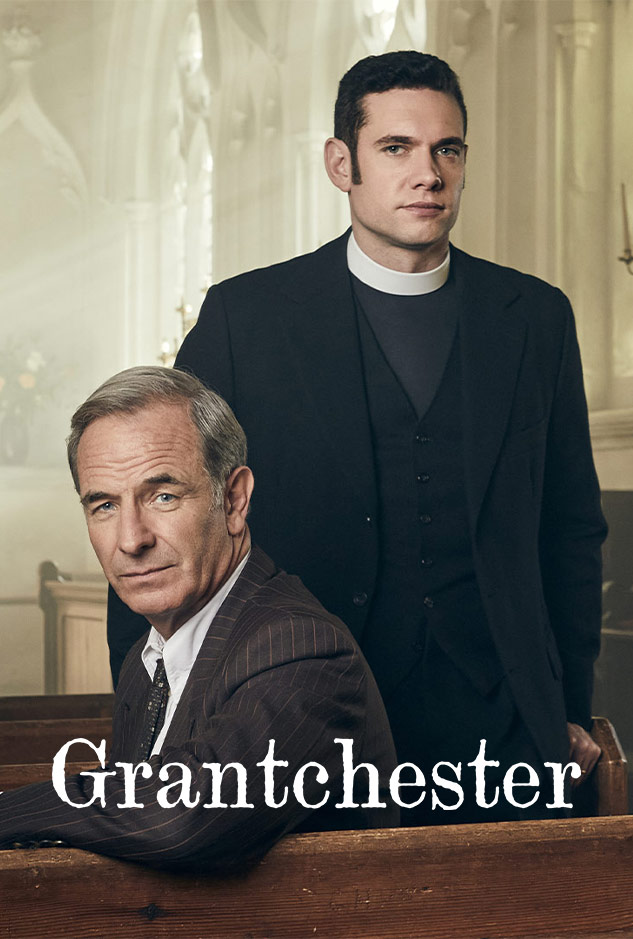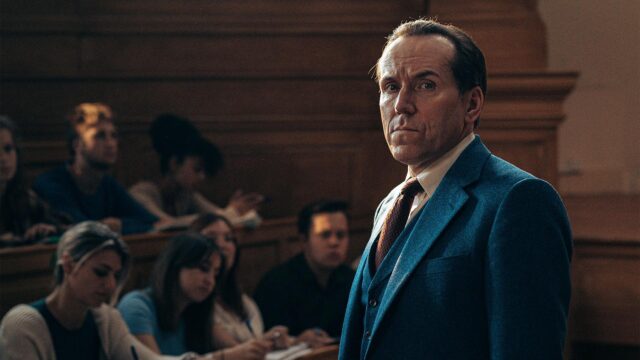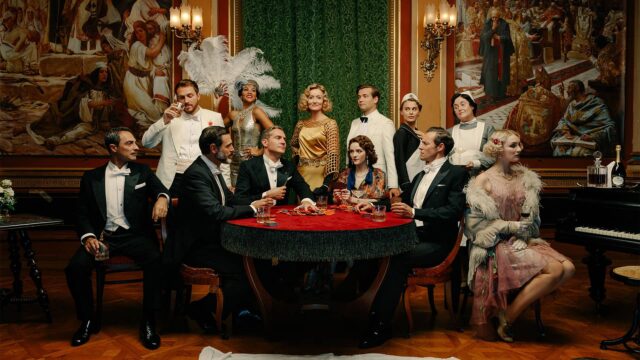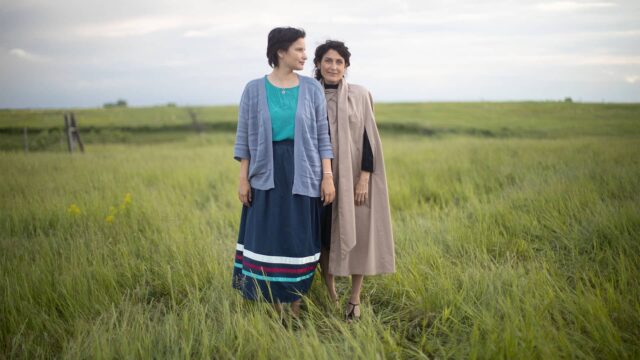Where Was Poldark Filmed? The Official Locations Guide
Get your definitive guide to five glorious seasons of Poldark‘s Cornwall, plus location revelations from the series’ production designer, and favorite hidden gems from Poldark‘s cast. You’ll soon be packing your bags to hit the iconic windswept cliffs, pounding surf, and sparkling seas that have thrilled us for so long with their tempestuous beauty—or at least, you can flex your credentials as a Poldark completist while adding these Cornish beaches on to your bucket list and binging the series all over again with PBS Passport, an added member benefit!


Jeff Tessler, Production Designer: Go up to St. Agnes Head, you can’t go wrong.
Jack Farthing (George Warleggan): Gwennap Head is pretty amazing, as long as you don’t get close to the edge! It’s just so dramatic and incredible and beautiful, and watching the sunset there is amazing. I’d say that. Or the beach in Holywell, it’s incredible. These big expanses, these dramatic expanses, I think, are very soothing.
Beatie Edney (Prudie): Around the mines, around Penzance. There’s a cliff where you can stare out at the sea, it’s spectacular.
Heida Reed (Elizabeth Warleggan): Botallack Mines, where the mines were—that’s a really good space to walk and have a self-reflective moment.
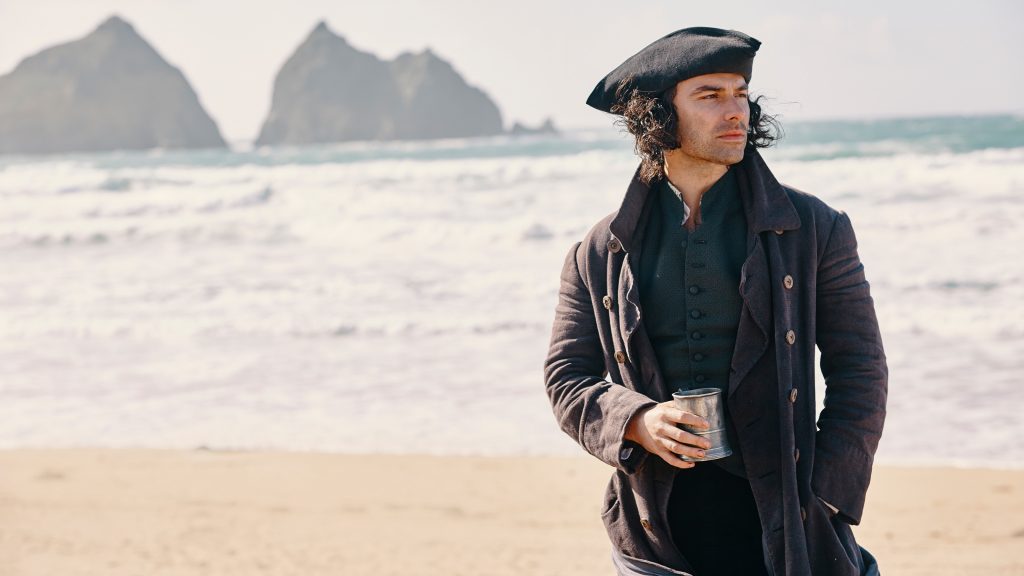

Location: Holywell Bay
This vast north coast beach meets a wide open bay and is instantly recognizable by Gull Rock (aka Carter's Rocks), the twin islets in the distance, as well as its slick mirror of golden sand when the tide has receded, and its rolling surf that pounds the wide and windswept beach.
Stands in for: "The best beach in Cornwall!" (according to Geoffrey Charles)
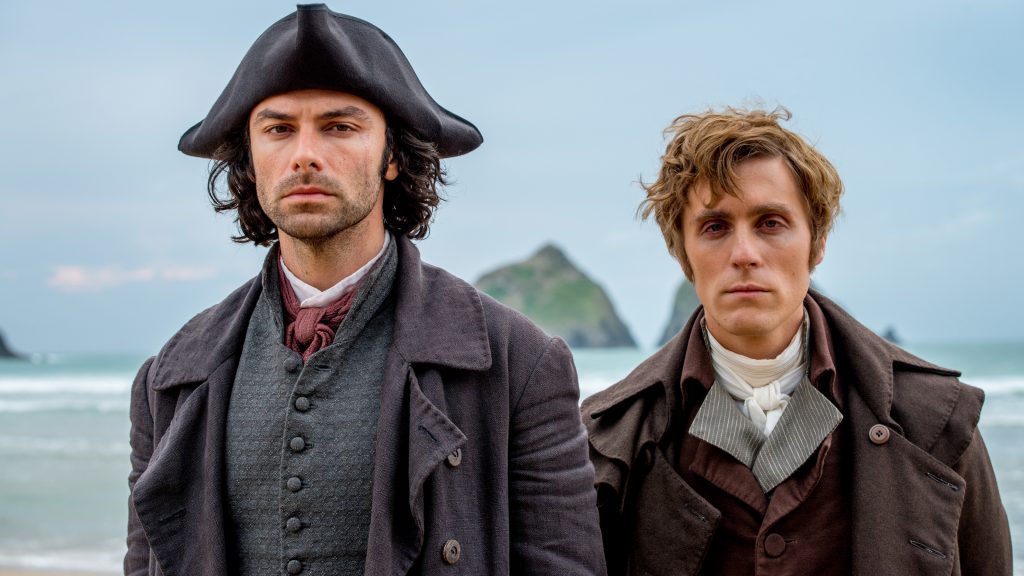

Holywell Bay
Memorable Scenes: Francis' flashback to running along the beach, as a child, with Ross, as he's drowning in the mine; Dwight and Caroline racing their horses together across the beach in Season 2; Geoffrey Charles, Morwenna and Drake frolicking during Season 3, the Holy Well where they make their wishes of love, and Ross and George's classic exchange at the end of Season 3: "What is it that you believe?" "That belief is a beautiful thing." In Season 4, Ross meets Dwight emerging from the sea in a celebratory swim upon the birth of his daughter, Sarah.


Holywell Bay
Memorable Season 3 Scene: Demelza and Ross argue the morning after Demelza rejected Captain McNeil and escaped from the party.
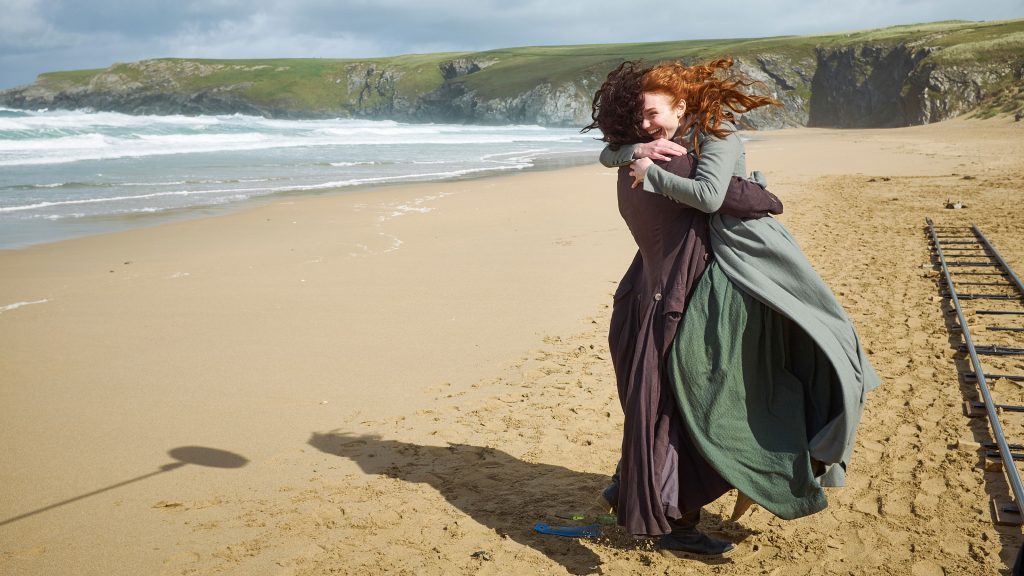

Holywell Bay
Memorable Season 4 Scene: Ross finally invites Demelza to accompany him to London.
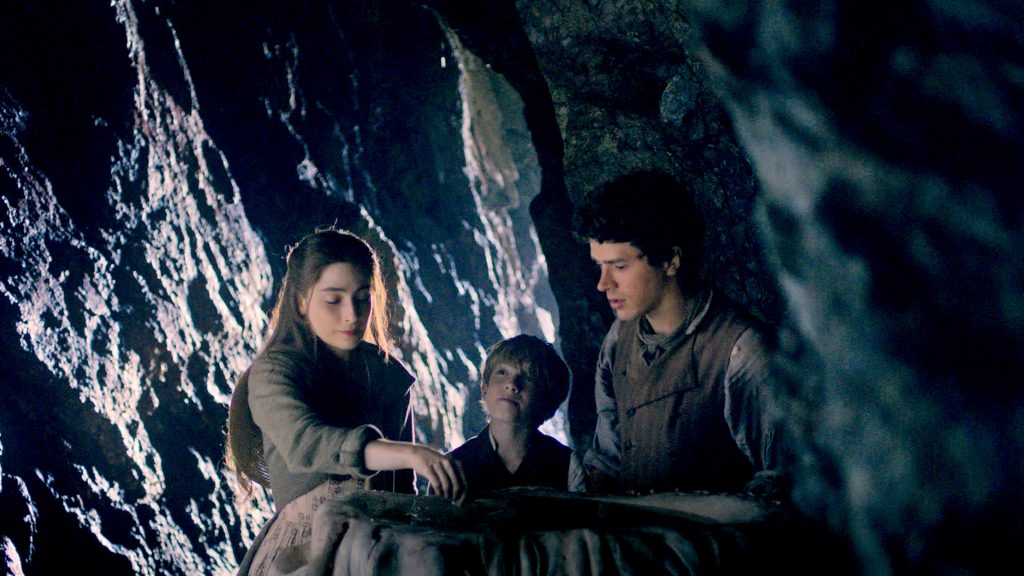

Holywell Bay
Did You Know: While the Poldark production built its own Holy Well, there is a sea cave with rock formation of stalagmites and stalactites at the far end of the beach, accessible only at low tide. It's also known as St. Cuthbert's Cave, and was once famed for its spring's legendary healing powers.
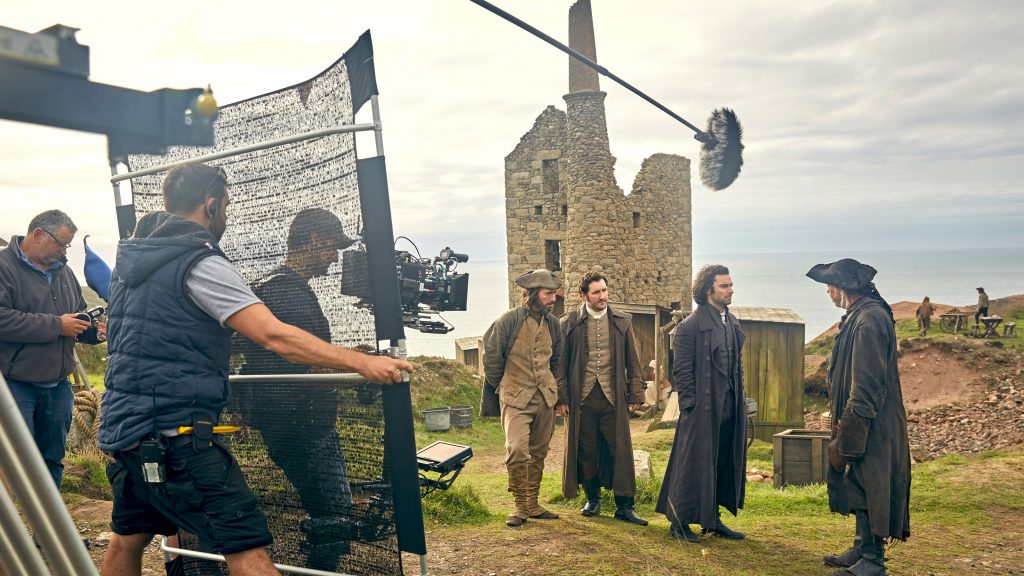

Location: Botallack Mine
With its engine houses clinging to the edge of the coastal cliffs, the mine complex at Botallack marks the World Heritage Site and ruins of Wheal Owles and "the Crowns." In its heyday, the mine employed some 500 men, women, and children, and had shafts that reached 570m deep and ran for half a mile out into the Atlantic Ocean!
Stands in for: With the help of some CGI, Wheal Owles for Wheal Leisure, and the Crowns for Grambler


Botallack Mine
Memorable Scenes: In Season 1, Ross declaring the Wheal Leisure mine open; a picnic scene where Demelza tells Ross, "I belong here." In Season 4, Dwight's emotional saving of the young miner who Ross brought up from the depths during the mine's flooding.
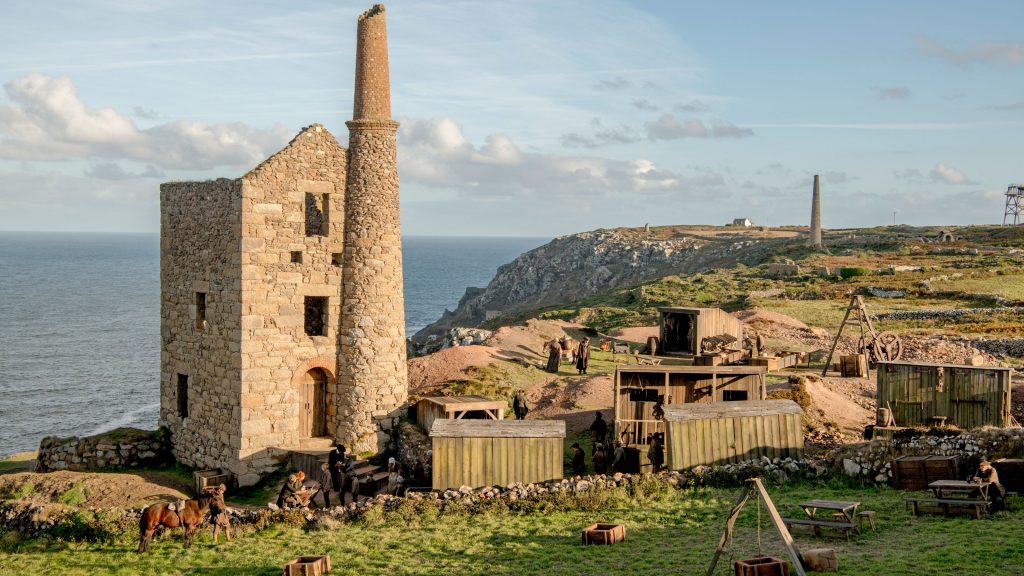

Botallack Mine
Did You Know: With its crucial role in the industrial revolution, Botallack hosted numerous eminent visitors, including the writer Wilkie Collins and nobility such as the the Prince and Princess of Wales, who descended into the shaft to inaugurate a new section of the mine in 1865. In addition to the coveted copper, tin, and arsenic, Botallack, over its history, also produced many surprising, precious minerals such as silver, amethyst, garnet, and tourmaline.


Location: Charlestown
This World Heritage Site and Grade II Listed harbor was developed in the late 18th century to service the fishing, copper ore, and china clay trades, and is still home to a number of majestic tall ships.
Stands in for: Truro and Falmouth


Charlestown
Memorable Scenes: Many of the series' comings-and-goings were filmed in Charlestown, but some of the most powerful include Verity and Andrew Blamey's elopement; Ross pondering, with disgust, the cargo loading of the Warleggan ship the Queen Charlotte; a reconciliation between Francis and Blamey, by way of Ross and Dwight, during Seasons 1 and 2; the riot at the beginning of Season 4 that implicated Jago Martin, Drake and Sam; an impromptu meeting between Demelza and Dwight while Ross.


Charlestown
Did You Know: The historic port of Charlestown Harbor is privately owned, and was bought in 2018 by entrepreneur Sir Tim Smit. The sale includes included the harbor, which stretches for 23 acres, its adjoining beaches, two shops, the roads, and the historic tall ships!
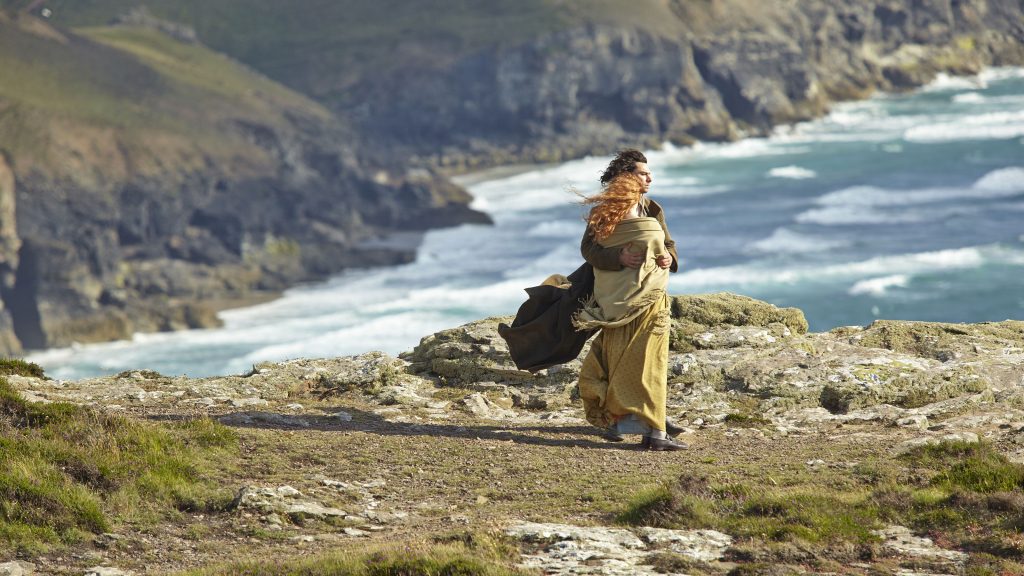

Location: St. Agnes Head
Cornwall's mining heritage can be embodied in the iconic ruins of the mine Wheal Coates, which resides on the edge of the coastal path at St. Agnes Head on Cornwall's north coast.
Stands in for: Nampara Valley, cliffs


St. Agnes Head
Memorable Scenes: Dramatic cliff-side horseback riding of all sorts
Did You Know: St. Agnes Head is just a few miles from Parranporth, where Poldark author Winston Graham lived and worked for 30 years, writing his first Poldark novel while stationed in the region on duty for the coast guard during World War II.
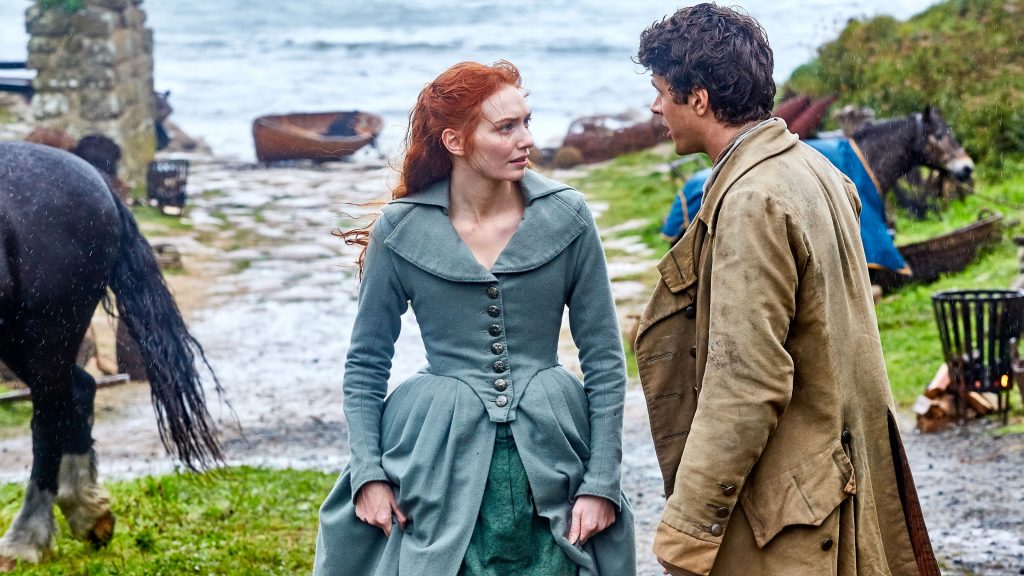

Location: Penberth Cove
Just 7 miles southwest of Penzance, Penberth Cove is a charming fishing hamlet comprising just a few stone cottages, a stream with stepping stones for crossing, and a cobbled slipway leading to the water.
Stands in for: Sawle, where Drake and Morwenna, Sam, Rosina, and other villagers live.
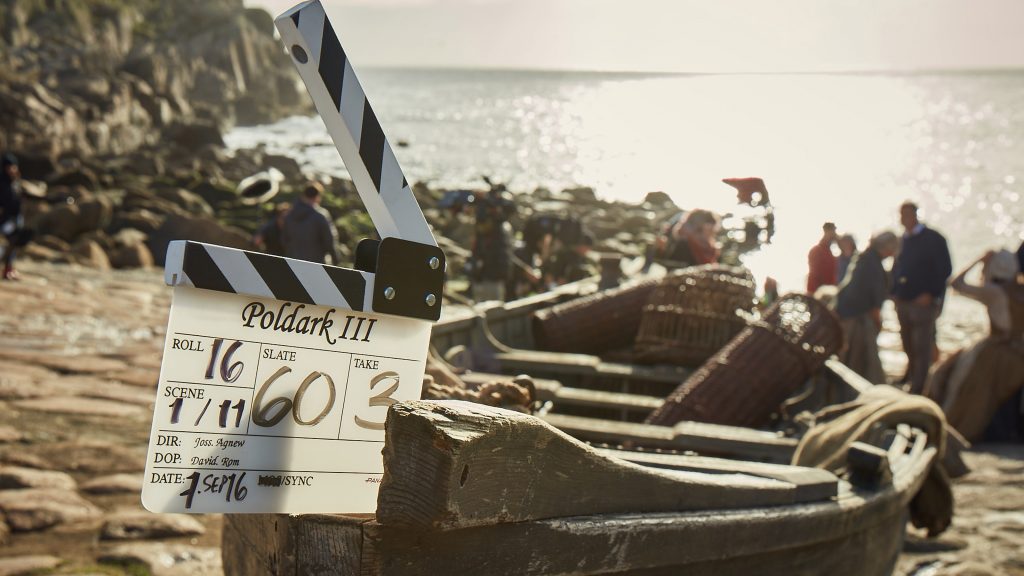

Penberth Cove
Memorable Scenes: In Season 2, Sawle is where Dwight first tells Caroline he has feeling for her, Tankard bribes and intimidates drunk Jud into testifying against Ross; in Season 4, Sam talks with Rosina about Drake, and later the two brothers are confronted by Rosina's father; in Season 5, Drake and Morwenna live in their Sawle cottage and Drake's smithy is located there.
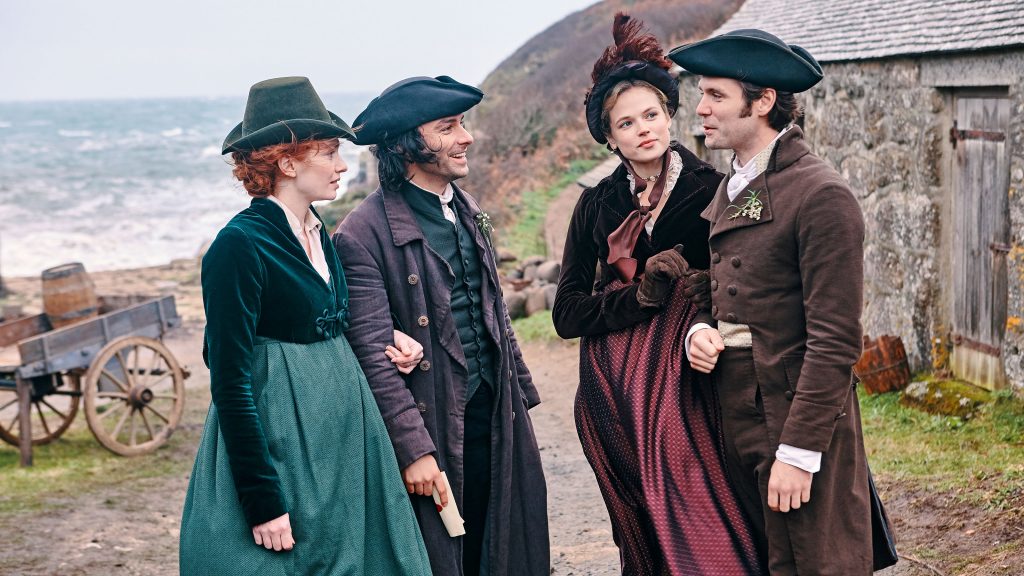

Penberth Cove
Did You Know: Much like Charlestown, Penberth Cove is nearly the same today as it was 200 years ago. Poldark production designer Jeff Tessler describes, "It's not a big tourist spot at all. There are no cafes or facilities like that...There's just four or five cottages where people live…We built the blacksmith's hut down there this year, and used the outside of one of the fisherman's sheds as the outside of Drake and Morwenna's cottage. Apart from bringing in some horses and carts and barrels and fishing nets, you don't have to do much. Once you put some locals in period costume, it brings the place to life. It's a really lovely spot…It's got that beautiful little stream running through the middle of it with the stepping stones. It's really charming."
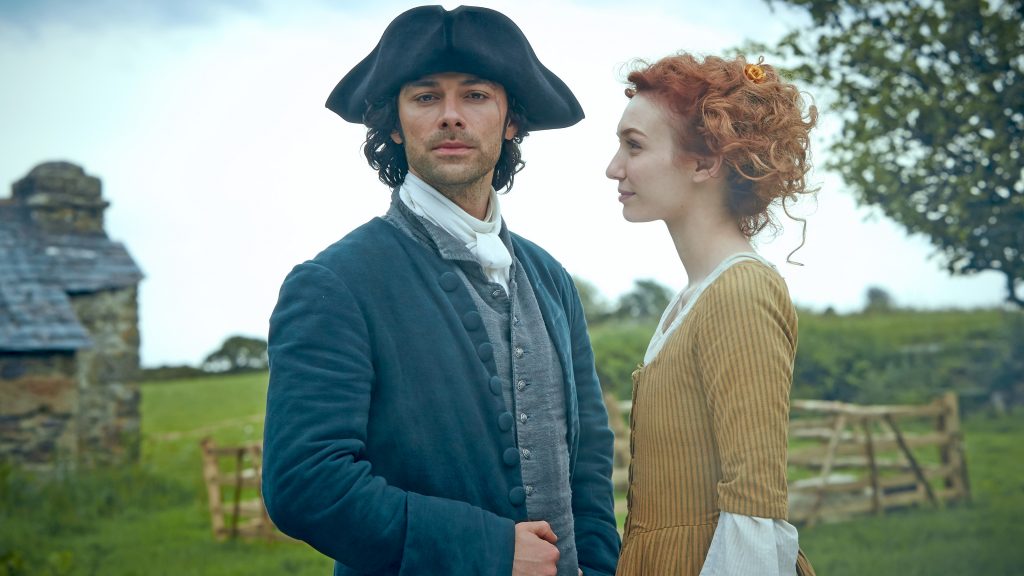

Location: Bodmin Moor
Location: Bodmin Moor
Bodmin Moor, located in northeastern Cornwall, is known for its wild and rugged beauty and its sweeping stretches of grass and heather, broken by tors of ancient stones and scattered boulders.
Stands in for: the exterior of Nampara, the miners' cottages, Dwight Enys' cottage exterior
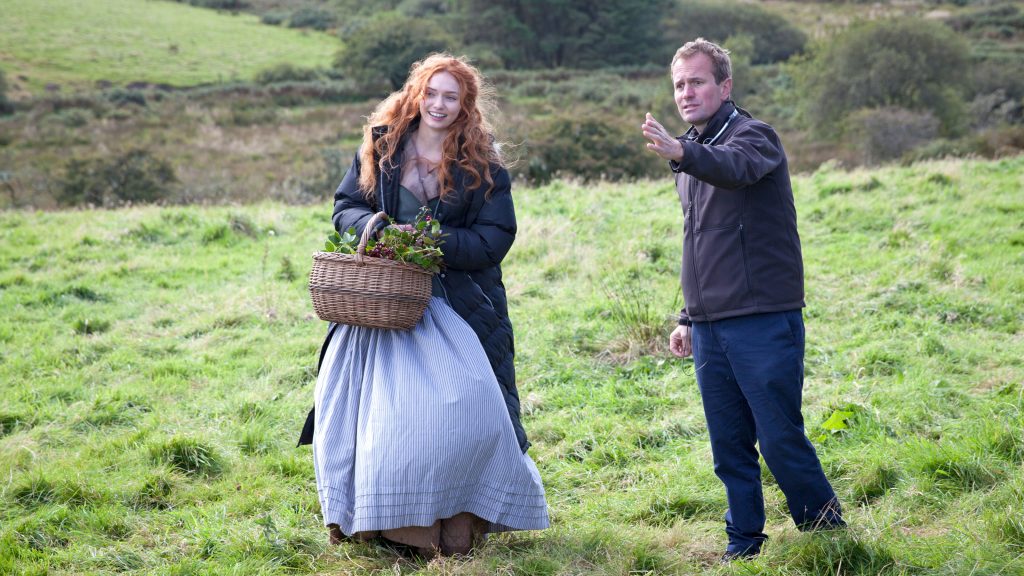

Bodmin Moor
Memorable Scenes: With the landscape's high drama and natural beauty, it's no wonder that Bodmin Moor is the location of the very heart of Poldark, Nampara. Ross and Demelza's emotional partings and reunions via horseback, and many of its carriage rides, were filmed there.


Nampara Set
Did You Know: Ivey Farm, a private slate and granite farmhouse in St. Breward (a village on the western side of Bodmin Moor) stands in for the exterior of Nampara house. The interiors of Nampara are a set in Bottle Yard Studio in Bristol.
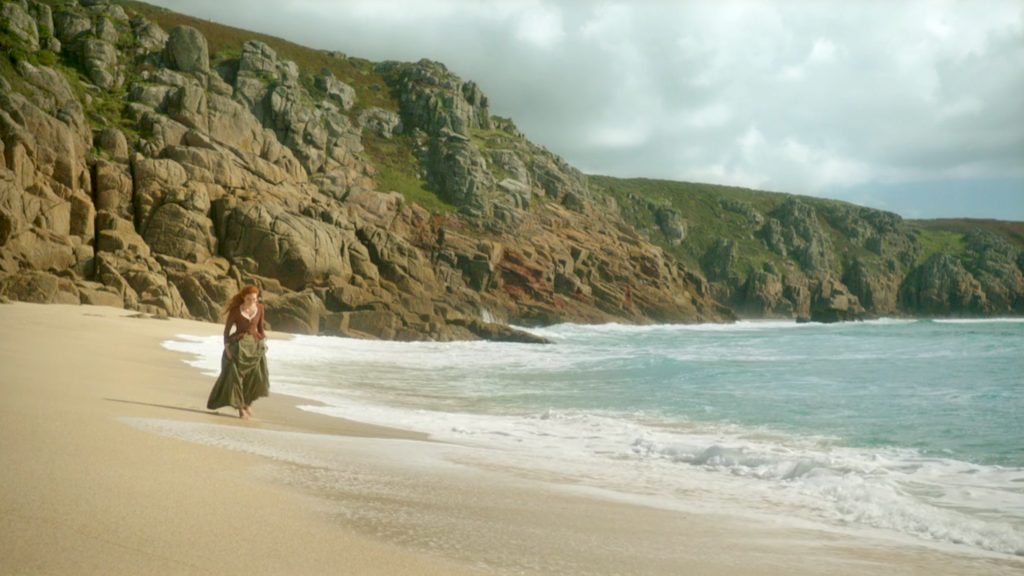

Location: Porthcurno
Bordered by high craggy cliffs, the fine, white-sand beach at Porthcurno features aquamarine water and proximity to the magnificent open-air Minack Theatre
Stands in for: Nampara Cove, Hendrawna Beach


Porthcurno
Memorable Scenes: While sitting in Bodmin jail, awaiting his trial at the beginning of Season 2, Episode 2, Ross has a flashback of walking hand-in-hand along Hendrawna Beach at sunrise, dappled in golden light.


Minack Theatre at Porthcurno
Did You Know: Minack Theatre, the open-air theatre at Porthcurno, is the favorite Cornwall location not just of Heida Reed, who calls it "breathtaking," but of Christian Brassington (Ossie Whitworth). He describes the experience, "The Minack Theatre at Porthcurno (near Land’s End) is a magical place. Hewn from rock, the stage is perched on top of a cliff so the sea becomes part of the scenery. If you want an unforgettable meal, there are few places I’d rather be in the world than eating dinner (and drinking wine) at Fifteen at Watergate Bay as the sun sinks into the Atlantic; the restaurant is perched above a sandy beach with full-length glass windows. Cornwall’s fantastic."
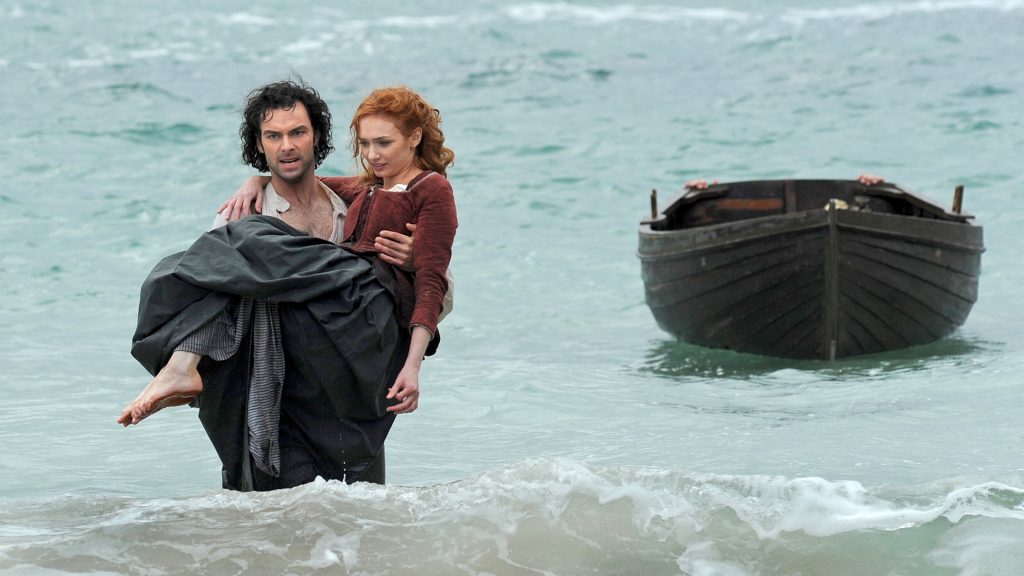

Location: Kynance Cove
Its turquoise water, serpentine rock stacks, and caves accessible at low tide makes this tidal beach one of the UK's most popular—and, only two miles from Cornwall's Lizard Point, nearly mainland Britain's southernmost.
Stands in for: Nampara Cove
Memorable Scenes: Cliffside horseback riding, Ross being marched off to jail at the very beginning of Season 2, and Demelza's ill-fated fishing expedition, where she goes into labor in her boat and has a shouting-match with Ross when he "rescues" her.
Did You Know: Among Kynance Cove's most celebrated visitors were Queen Victoria and Prince Albert!
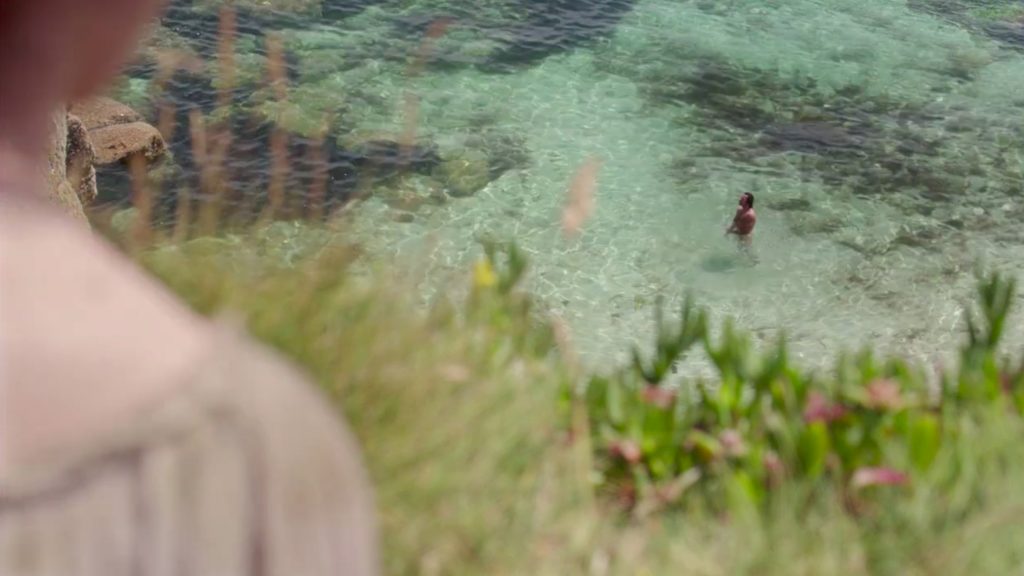

Location: Porthgwarra
This unspoiled, secluded cove, surrounded by wildflowers and birds, sits in the St. Aubyn Estates in the Penzance area of Cornwall.
Stands in for: Nampara Cove
Memorable Scenes: Where Ross skinny-dipped in Season 1 and Ross and Demelza helped bring in the life-sustaining pilchard catch.
Did You Know: Porthgwarra has a little beach café that supplied the cast with Cornish pasties during the location shoot.
Interview: Poldark’s Production Designer, Jeff Tessler
In an exclusive conversation with MASTERPIECE, Poldark’s production designer, Jeff Tessler, revealed five seasons’ worth of insider information about the challenges and rewards of shooting Poldark in Cornwall. Discover his list of hidden gems, favorite spots, most iconic locations, most difficult to shoot at, what makes Cornwall so eminently magical, and much more!
MASTERPIECE: Out of the many different Cornwall locations, which were your favorite?
TESSLER: It’s difficult because my memory is a maze of everywhere in Cornwall. The most interesting to shoot, I guess, is Charlestown Harbor because you’ve got the ships there and it is unique in a way. It’s really the only place in the country that you can see those tall ships in a setting that’s really hardly changed since the 18th century. Apart from the odd coffee shop, it’s very, very much the same as it was in Poldark‘s time. So it’s a pleasure for us to use. The ships are wonderful. All you’ve got to do is cover up a few of the bits of plastic on the decks and bring in the props and the barrels and the crates, and all those things that would have been used as cargo at that time. It’s great to bring that to life by bringing in the characters in costume, and the horses and the carriages. You’re looking at it and you think yes, this is really what it looked like 200 years ago. Charlestown’s a very special place.


MASTERPIECE: Which of the different locations was sort of the most challenging in terms of logistics?
TESSLER: Well, the hardest to shoot in is the mine, Botallack, where we shoot the main mine scenes, because obviously there’s very little left of the actual mine there, just the basic remains of the central mine building. We build the various wooden huts and mine workings around the base of the area. The difficulty is that it’s on the edge of a cliff, very windy. You’re very exposed to the weather.
We always had as little time as possible to get everything built because the land is owned by the National Trust, and it’s expensive to shoot there, and the access is very difficult. So it’s an awkward place to shoot. We were always trying to get in and out as quickly as possible while still being at the mercy of the wind and the rain. There are times when you have to measure the wind speed because if it goes over a certain speed, you’re not allowed to work there. You’ll be sent away because it’s not safe.
Then you’ve always got the worry that once you’ve put those huts up, they’re going to get blown away. Of course, you’re not allowed to dig anywhere because it’s a Heritage site. You can’t dig into the ground at all, so it all has to be done very carefully—you can’t move any of the existing stones or rocks that are on the ground. You have to place your rigging very carefully amongst the existing remains, then you have to weight everything down sufficiently to make sure it’s all going to be there.


We had a few difficult times, when it rained very heavily and the wind was high. From a designer’s point of view, you stand there thinking Oh, fingers crossed, I hope it’s still there in the morning. Luckily, it was. It was always difficult to work there, but you know, it’s a fantastic setting. Just to be with the mine works and see the coastline and the sea from the base of the mine is great. It’s hard to get people to agree to work down there, it’s a very exposed spot to work in. But it’s fun, and it always looks wonderful in the show.
MASTERPIECE: In Poldark we often see the passage of time through different seasons. Did you have a favorite season in an artistic sense, and then a favorite season for shooting the show?
TESSLER: Well, it’s very difficult, because basically, we would go to Cornwall for a period of time, usually about three weeks in September, and shoot bits of all eight episodes. The problem is that you can’t control the season. We shot the last season all together between September and February. But we were shooting parts of all eight episodes all through that period. So showing the passage of time in the seasons is a very hard one for us, because you’re cutting together scenes that were shot in September with scenes that were shot in February, and they were supposed to be in the same time frame.
Essentially, that’s one of the biggest issues for us, to try and show the passage of time when you’re having to shoot multi-episodically. It is very difficult. I think that one of the ways we got around that is to have moments in the episodes where we’re looking at close-ups of rain falling on leaves, or sunshine through clouds, moments which are not necessarily about dialogue, or character, or narrative. They’re about showing the seasons, showing nature and the period of time that you’re in. Quite often, you’ve actually shot a scene that may be in the wrong season, but by editing in those moments that were shot at the right time, you can suggest to the viewer the period that you’re in.


September is generally a good time to shoot in Cornwall, but within the three weeks we were there, we’d get everything from great sunshine to terrible rainstorms. Somehow you just have to keep shooting and hope that the camera sees what you want it to see.
MASTERPIECE: Which do you think is the very most iconic Poldark location?
TESSLER: Obviously it’s Nampara. Everything revolves around the Poldark house. It’s actually made up of a number of different things: part of it’s a set, part of it were exteriors that were shot at a farmhouse on Bodmin Moor. Some of the other exteriors were shot in the Cotswolds in Bristol, a long way from Cornwall. You’re putting together that sort of jigsaw. But really, in the show, you’ve traveled emotionally between Nampara and Trenwith all the time, between Ross and George, Demelza and Elizabeth.


Oddly enough, it’s the journey between those two houses—that’s what you see of Cornwall. It’s that ride across the cliff tops, seeing the Cornish landscape, and you know that Ross is on his way to see George, or Elizabeth’s running across to Nampara. It’s those moments and those shots across that cliff top that make the heart sing, really, the emotional heart of it. Then because most of the houses and interiors that we use were not shot in Cornwall, they’re shot mostly around Bristol where the sets were built. So, you use those great sequences on the cliffs in Cornwall to link everything together. I think we did, obviously, go back to the same stretch of coast over and over again because it roots the show, and it’s a journey that everyone’s come to recognize. You’ve got the great scenes of Ross on that great black horse riding on the cliff top. It’s always wonderful to see.
There’s various different bits of cliff top. We worked in St. Agnes Head, which is a great piece of cliff top, which is slightly further north of where the mine is. So you’re on the northwest coast, I suppose. Then we would go right down to the areas near Botallack and St. Just, the cliff top there. We moved around a lot, but essentially, there were just two main areas of cliff top.
Then the beach at Holywell was the main beach, with a wonderful, huge, long sand beach there, which we used a lot. Hopefully it all links together and feels like one place. But actually, there was quite a long distance between the different locations we used. We tended to spend half our time in the kind of northern area above Newquay, and between Newquay and St. Agnes. Then we’d go down, nearer to where the mine area is at Botallack, and work around there.
MASTERPIECE: Holywell: Is that the beach that has the rocks out at sea, where Drake and Morwenna made their wishes, at the wishing well?
TESSLER: Yes, there’s a great cave there; we built the little wishing well within it. It’s a wonderful place, and that’s the one we used, mostly. It’s got that long stretch of sand with a little section of rocks that come out into the beach, that just separates off one side of where the caves are, from the main beach. It’s a beautiful area.


MASTERPIECE: That beach confuses me, because sometimes it seems to be the one owned by the Warleggan’s, but other times Ross and his people are there…
TESSLER: Well, the problem is that because of the tides, you’re quite restricted on where you can do various things. There’s a beach that we used sort of as the Nampara Cove beach, but the rocks are too dangerous there to actually put the rowing boat out to sea. So, there’s an amount of cheating that goes on. We did try to use different parts of the beach for different sequences, but that’s a hard one, because for any shooting on a beach, you get very restricted by the health and safety requirements. So, if you got scenes where Ross had to go in the water, then you can only do that in a couple of places. If you have to launch a boat, that’s difficult. Those are not necessarily the beaches that are the most dramatic. So you would go somewhere else for the smuggling scene, for instance.
MASTERPIECE: There are so many extreme action events over the course of the series. What were those like for you? Did you enjoy doing them?
TESSLER: Those are always fun to do. Of course, for the big mine rescue in [Season 5] Episode Three, we shot the outside of that, when they bring the miners out, on the beach. We shot that, I think, on Holywell Beach, at one end which we’d never used before. We shot that in September, and we shot the inside of it on a set that we built in February. That was difficult. It really was a stretch. It was one of the last sequences we shot for the interiors. But the whole of that, because that was so specific, with Ned jumping over the chasm in the rocks, and Ross going to save him. We looked for mine workings in case we could shoot that in them, but it’s so specific, and so difficult working in places like that, that we built all of it in the studio, in the end. It was one of the last things we shot. Strangely enough, the end of that sequence was one of the first things we shot. It was right at the end, nine months later. They’re great to do, those scenes, working out how to do it. You know, it’s easy for Debbie to write, but it’s not so easy to find places or build places to make them work. But when you manage to do that, it’s great fun.
MASTERPIECE: Sometimes, you’re shooting in real mine workings. I’d be terrified. What’s that like?
TESSLER: Well, you have to be careful. In truth, most of the mines are covered up now. The remains of the buildings that are left are fairly safe because they’re open, exposed to the public now. So the actual entrances to the mines are mostly covered up. We shot some of the interior mine scenes that appear in the later [Season 5] episodes…in caves, which are not so far underground, but they’re quite difficult to work in. I always get lost in them, however many lights and signs that people put up. Once you’re inside, they’re pretty dark and one passageway looks much like another. I’m forever getting a bit lost. You do get used to it, but they are times that there’s a dankness in the air which will get into your chest. You don’t want to be working in there for too long.
As I said, we built that big set for the stunt sequence, but the going into the actual place gives you a depth and a journey that you can’t really build. The atmosphere of the old workings is great and they’re worth using but you do have to come up for air every now and then. You really do get a sense of what it was like for those guys, down there with a candle in their helmet and not much more, no protection. It was terribly dangerous; there were rock falls and gas escapes, and it was a long, long way underground. You see the workings of the mine on the top of the cliff, but the actual mine itself was way down under the sea, and out for half a mile or more, a very, very long way down and along. It would have taken a very long time to get to the coal face, or the copper face, or whatever it was they were mining.
The truth is, that’s what a lot of mining still is for a lot of people. It’s a hard, hard, industry. And actually they may have slightly better lighting and mechanics these days, but I’m sure it’s no pleasure for anyone, going down in those rattly old cages or down those ladders. Certainly in those days, in Poldark’s time, it would have been very frightening, but they had no choice. It was a huge industry. And it was Cornwall’s great money-making business. Apart from farming, there wasn’t much else that the people could go into. It was an essential industry and they did it whether they liked it or not. And from a very young age, of course, children were five, six, seven going down the mine. We think we have it hard now, but it was tough then.
MASTERPIECE: Is there a location that was a true hidden gem, that you stumbled upon in making this series?
TESSLER: In Cornwall, that’s Penberth Cove, the village that we used for Sawle. It’s now owned by the National Trust but it’s really just one row of houses, and a couple of huts. But it’s a fishing village that’s still used by two or three local small fishing boats, so it has a slope that goes down to a quite enclosed harbor. It’s a really beautiful place, quite awkward to get to. It’s not a big tourist spot at all. There are no cafes or facilities like that. Because it’s tucked away and quite awkward to get to, it never has many visitors—just people who walk along the coast and go through there, walkers and their dogs coming down one hill and going up the other side. They’re always taken slightly aback to see a film crew there.


There’s just four or five cottages where people live…We built the blacksmith’s hut down there this year, and used the outside of one of the fisherman’s sheds as the outside of Drake and Morwenna’s cottage. Apart from bringing in some horses and carts and barrels and fishing nets, you don’t have to do much. Once you put some locals in period costume, it brings the place to life. It’s a really lovely spot…It’s got that beautiful little stream running through the middle of it with the stepping stones. It’s really charming.
MASTERPIECE: Over the course of making five seasons of Poldark, did much change for you?
TESSLER: Well, over the series, the actual Cornish locations didn’t change a great deal. Sawle village changed after Series 1, and actually the exterior of Nampara, we changed after Series 2. For various reasons, either we weren’t able to go back to certain places, or the schedule didn’t allow time to get somewhere. We changed a few things, hopefully things that the viewers aren’t too aware of. I think the thing that changes in the series, when you get to, really I suppose series four, is the fact that Ross goes to London and becomes an MP. So there’s a noticeable change for us: you’re looking at two very different worlds, where you’re contrasting the world of Cornwall and Nampara, with the world of London at that time. It changes the nature of the show, and for us, it was something we were very conscious of, because we only had so much time to shoot in Cornwall, and so much time to shoot in London. So a lot of it is cheated around Bristol, where we were based. Obviously, we built quite a lot of sets. So, the challenge was finding a way of contrasting the lives of people in those two very different worlds.
Certainly, in Series 5, we spent a lot of time in London in the story, although we only shot in London itself for I think two days…But creating those two worlds for us was the challenge, contrasting the two. It’s always interesting to see London, to see Ross slightly out of his element. And then it’s always great to get back to Cornwall, isn’t it? That’s where the heartbeat of the show is, really. Especially because a lot of the time, Ross is separated from Demelza, and what you really want is for them to get back together again. So emotionally, when he’s left her to look after, all the hard stuff’s going on at home. When he gets back from London you always think “Ah, now the world’s gone right again.”









